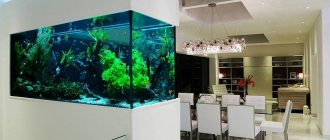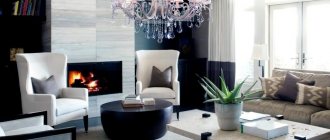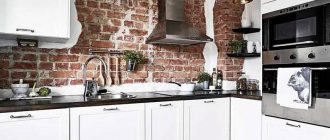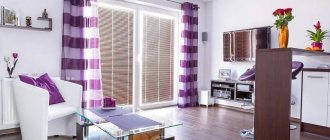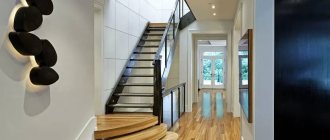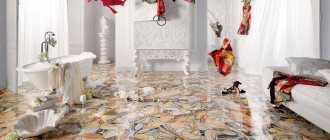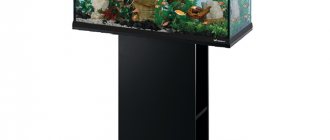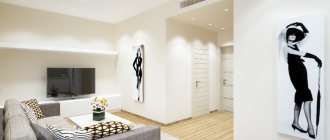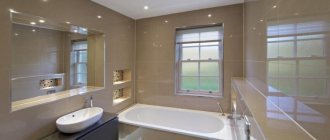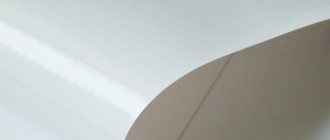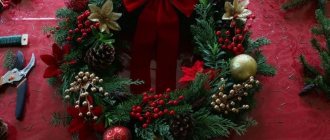An artificial pond in the interior of a home plays the role of a bright accent. A coordinated composition with thoughtful details does not fall out of the overall design of the room, but becomes a natural extension of the room. There are many original design techniques that will make a fish tank unusual.
Beautiful interior Source roomester.ru
Built-in aquarium in the kitchen Source srbu.ru
Unusual work apron Source www.topdom.ru
Basic styles
Aquarium science distinguishes several types of aquarium design. But everyone is able to complement and improve aquadesign. Below are the main decorative styles for aquariums.
Dutch
This style first appeared in the middle of the last century and is still popular among aquascapers. The peculiarity of the Dutch style is the more, the better, or the complete filling of free space. This is especially true for the bottom part. Do not leave empty areas at the bottom. A large amount of vegetation of different levels is planted, the contrast of red and green colors is especially welcome. In the middle, attention is drawn to a snag or a structure made of large stones.
Pseudo-sea
Creating a pseudo-marine style does not require large investments. It requires standard soil and undemanding plants. The backlight is preferably blue. For additional resemblance to the sea, shells, artificial shells, and corals are used for the soil.
Natural
When using a natural style, it is important to create an interconnected and holistic composition of nature. There are several completed variations in the natural style:
- Rock garden. The main part of the decorations are stones. Sometimes stone figures have a hidden meaning.
- Iwagumi. Stones and Japanese dwarf trees are used, complemented by figures of houses, ships, and boats.
- Reboku. The focus is on driftwood and large stones.
- Wabi-kusa. A distinctive feature of this option is the presence of a moss hummock above the surface of the water. The plant that is used as tussock is called wabi-kusa, hence the name.
Aquascaping in 100 liters
This volume of the vessel expands the boundaries of creativity. Here you can use different aquarium plants, decorating it in the Dutch style, or use a minimum of elements and create aquascaping in the style of an Iwagumi or Zen garden.
You can put a small artificial castle on the bottom of the aquarium
Home aquarium design option
For example, decoration with Eleocharis sp. "Mini" will create a soft lawn that does not grow and does not require regular mowing. You can also supplement the aquarium with a couple of stones and a driftwood with moss in the form of a bonsai. To do this, you can use Java moss, which is unpretentious in cultivation, and the only requirement for full growth is an established carbon dioxide circulation system. In dim light, Java moss will have an oblong shape and a light shade; in bright light, its texture will be denser, and its shape will be more compact and neat.
An aquarium with algae and pieces of wood will look very beautiful
You can put stones in the aquarium
The aquarium can be built into the interior opening
See alsoPaper decor for all occasions
General instructions for setting up an aquarium
When decorating an aquarium with your own hands, there are certain fundamental principles. The main one is that when decorating an aquarium, underwater pets are moved to a separate tank. This will help avoid injury, damage and stress to the fish. It is better to move the water along with the fish so that their body does not experience additional stress due to a sudden change in water. After decorating, pour water into the aquarium.
The second rule is mandatory disinfection of all new items with which the aquarium will be decorated. Even items that cannot be replaced are processed after some time.
Aquarium invertebrates
Some types of aquariums do not require the presence of fish , but this does not mean that you need to completely abandon the presence of fauna in the reservoir.
Invertebrates such as snails or shrimp can be an excellent alternative. They not only diversify the interior of the reservoir , but also help maintain the microclimate in it.
Decoration stages
Creating an aquarium design takes place in several stages and affects all areas.
Background
To decorate an aquarium, films or models made independently are used as a background. The right choice of background visually increases the space and creates the integrity of the underwater design.
Priming
For beginner aquarists, it is recommended to buy ready-made soil mixtures. When making soil yourself, it is difficult to take into account all the criteria, for example, particle size, color of the soil, what origin the soil is from. But when deciding to choose the soil yourself, take into account the type of fish and the general background of the aquarium.
What materials can be used?
Before you start decorating the aquarium, you need to choose the direction, the concept in which the work will be carried out. Next, you should develop a design and select materials in accordance with it. The main thing is not to forget that the priority is the living conditions of the aquarium inhabitants, and the design is always secondary and is organized taking into account their requirements.
The main materials used for decorating aquariums include:
- metals;
- glass;
- driftwood and other organic matter;
- ceramics;
- minerals and rocks;
- plastic, rubber, foam.
When choosing a material, it is important to consider how it interacts with the aquatic environment. If its presence is detrimental to the biological balance, the problematic material must be removed from the aquarium.
For example, most metal objects in water oxidize and spoil the composition of the water. Various varnishes and other coatings save the situation, but over time they also become covered with cracks, and the water becomes contaminated with oxidation products. Metal products are extremely rarely used for decoration.
Filling procedure
When decorating, there are several stages that are mandatory for anyone who decides to engage in aquascaping.
- Choose a design style or develop your own design.
- Buy selected items from a pet store.
- Treat stones and wooden parts if you choose them outdoors.
- Process purchased items.
- Fill up the soil.
- Arrange the decorative pieces.
- Secure the equipment.
- Plant plants if necessary.
- Fill with water.
- Add underwater inhabitants.
If you use sea corals to design an aquarium, they are placed in the aquarium only after all inhabitants have settled.
Developing an action plan
It's a good idea to come up with a plan of action. Firstly, it is always easier to act according to plan. Secondly, you will have a list of necessary decorative elements and equipment .
Thirdly, having ready-made instructions for action, it is much easier to adapt to unexpected circumstances.
Filling procedure
It doesn’t matter in what style the work on designing the reservoir will be done - in order for it to function for a long time, there are a number of general rules for starting it up:
- At the time of filling the aquarium with decor and starting the aquarium, the fish should be kept in a separate small tank, undergoing quarantine before moving in.
- All decorative elements must be disinfected so as not to become a source of infection for living organisms.
- When all the necessary equipment is installed, you need to make sure that it is in working order.
- Let the filled reservoir sit for a week to form its own microclimate, and only after that introduce inhabitants into the aquarium.
Aquascaping Ideas
- An aquarium with large objects and large inhabitants.
- Minimalistic style.
- Using corals.
- Use of fluorescent parts.
- Create an opening in the wall.
For 50 liters
A small 50 liter freshwater aquarium will be a good preparation before purchasing larger tanks. It is easy to maintain such a volume; it is easier to provide the necessary conditions and install aeration and filtration systems. Slow-growing plants take root well in such a space, but it is not recommended to plant fast-growing ones; they require frequent pruning of overgrown parts. Not all types of fish can live in a space of 50 liters, only small and medium-sized ones. For example, swordtails, guppies, zebrafish, molynesias. Larger species will not have enough space.
Equipment - how to disguise
The issue of equipment camouflage is most acute in natural biotopes.
Partially, the problem can be solved by plants , which successfully hide tubes and wires, but the devices themselves have to be covered with large decorative elements (stones, driftwood or ruins of buildings, masterfully integrated into the interior).
Photo
Stones
Using stones is the easiest way to create a natural relief in an aquarium. Use artificial or natural stones. The latter look much more attractive, but require processing - thorough washing and disinfection. In addition, it is necessary to take into account the influence of natural stones on the composition of water.
The best stones for aquariums:
- granite;
- frozen magma;
- quartz;
- petrified wood;
- slates;
- large pebbles.
Use carbonate stones with caution. They change the properties of water not for the better for fish and plants. To check if a rock is safe for your aquarium, drop a little vinegar on it. If it bubbles and sizzles, the stone contains carbonate.
Damage to the aquarium is possible from:
- marble;
- alabaster;
- dolomite;
- corals;
- limestone;
- crushed shells;
- different types of sandstone.
Do not place heavy stones on the glass. This mistake is often made by beginning aqua designers. Under the weight of the stone, the aquarium glass may crack.
Pseudo-natural landscape
The pseudo-natural style in the interior of an aquarium is recreated using corners of nature. The place will include artificially created scenery of mountains or, on the contrary, gorges and some architectural objects. The landscape turns out to be realistic with some fantasy elements. A sand waterfall will be a wonderful addition to the landscape. It is created using a pump, which is aimed at blowing out fine white sand. This design should be avoided if the interior is in a classic or modern style.
Other items
When creating conceptual, thematic landscapes, aquarists use a variety of objects - these can be castles, sunken ships, treasure chests, mermaids, artificial crabs, etc.
Often, aquariums are kept solely for decorative purposes, and to make their care easier, they do without fish. Such aquariums are called herbal aquariums; they have a lot of vegetation, and the fish are replaced by synthetic dummies. Such “fishless” aquariums are often used to create fabulous or seascapes.
